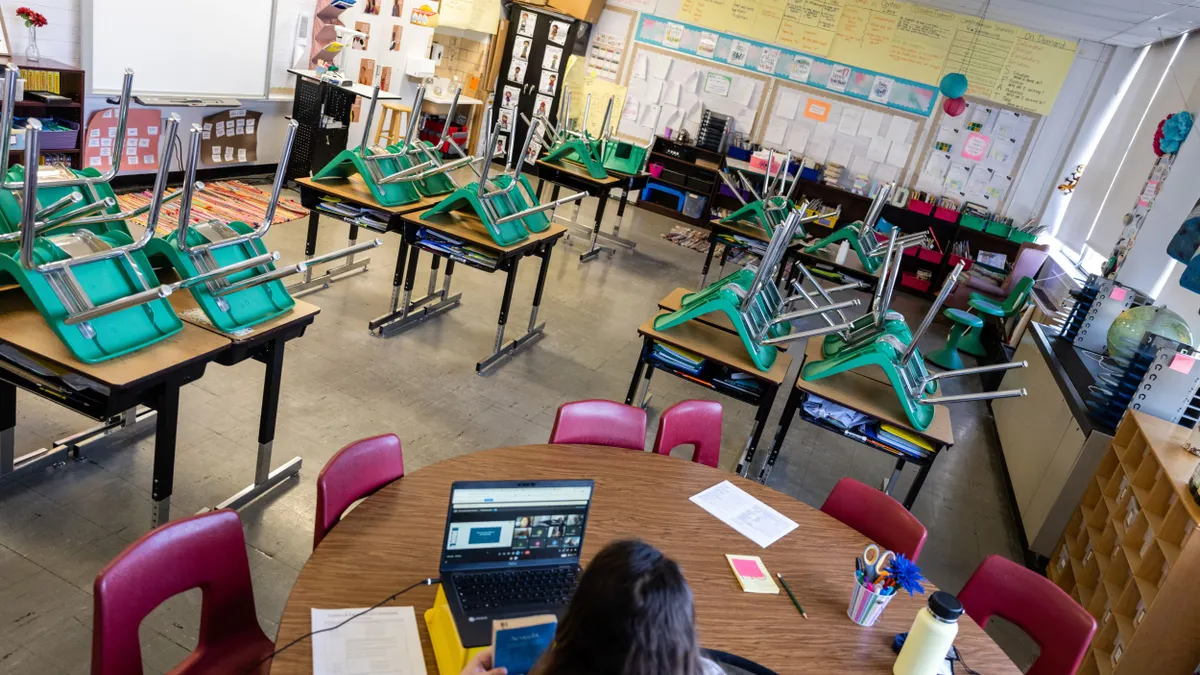Middle and high school English learners who had extra academic time — whether during summer programs or additional periods in the school day — were "far more likely" to be enrolled in core classes required for graduation, including math and English, according to unpublished research conducted by the National Research and Development Center to Improve Education for Secondary English Learners.
The research shows, among other data, that only 73% and 71% of ELs are in English language arts and math courses, respectively, when they do not have extra instructional time. However, those percentages rise to 96% for English language arts and 97% for math among ELs with an extra credit per year.
Enrollment in core classes is vital to meeting the requirements to earn a high school diploma, yet several policy and practice barriers can stand in the way of ELs' participation, said Ilana Umansky, one of the center's researchers and an associate professor in the College of Education at the University of Oregon.
Umansky and other researchers are working with the center, which has a 5-year $10 million grant from the U.S. Department of Education, to study how states and districts can remove barriers to ELs' full access to rigorous instruction. The grant period began in 2020.
Achievement data for secondary EL students shows lower graduation rates and academic performances compared to the overall student population, said Elizabeth Albro, commissioner of the Education Department's National Center for Education Research.
The adjusted cohort graduation rate for ELs was 71% in the 2019-20 school year, compared to an overall graduation rate of 87%, according to federal data.
Evidence of low academic outcomes for ELs drove the creation of the grant to study opportunities to improve secondary EL academic experiences through both policy and instructional strategies, Albro said. She emphasized that the center is not monitoring current policies or mandating curriculum, but only undertaking reviews in search of best practices.
Middle and high school ELs make up about 5.5% of the population of a given grade, according to Albro. For all grades, more than three-quarters of ELs were Hispanic in fall 2020, data reported by the federal government shows.
"I think one of the really interesting findings that's coming out of the policy work — where we're trying to understand what are some of the implications of policies that states and districts have — is that these policies are unintentionally making it next to impossible for English learners to graduate on time," Albro said.
Barriers and potential solutions
According to Umansky, one barrier ELs face is that they are disproportionately placed in lower level classes or separate classes such as English language development courses, which may unintentionally impede a student’s ability to access course credits needed to graduate high school within four years.
"Students who are classified in school as English learners face academic tracking in very unique ways and there's increasingly, I think, a recognition of this and understanding of the problems with regard to academic tracking of English learners," Umansky said.
Research of Oregon students by Umansky and others found 1 in 10 middle and high school ELs were not enrolled in any English language arts courses. The same ratio were not enrolled in any math courses.
New efforts at local, state and federal levels to support middle and high school English learners are aimed at raising graduation rates and students' inclusion in rigorous core courses, said those working on the research.
A law passed in Oregon in 2021, for instance, makes several policy changes to recognize the academic progress of multilingual students. The changes the law makes include:
- Repealing a state statute requiring that nearly all instruction be conducted in English. This allows districts to offer content area courses in languages other than English.
- Changing the definition of "world languages" to include sign language, heritage languages and languages other than a student's primary language.
- Expanding opportunities for schools and districts to offer course credit options for multilingual students. For example, a district can offer students taking an English language development course credit toward world language class requirements, as long as the course covers world language standards.
These types of changes could have a very positive impact for ELs who were struggling to take English development classes in addition to a full load of core academic content classes, Umansky said. In Oregon, less than 50% of 9th grade ELs were taking a full core content course load during the 2015-16 school year, she said.
The Education Department's Office for Civil Rights issued a fact sheet this month reminding schools that they cannot limit participation of ELs in advanced or specialized classes due to their limited English proficiency unless an advanced or specialized program requires proficiency in English for meaningful participation. The fact sheet said ELs were three times less likely to be enrolled in Advanced Placement classes, compared to non-EL students at schools that offer those classes.
Other barriers ELs face include policies that prevent ELs from enrolling in English language arts classes until they gain English proficiency, as well as course failure due to lack of accessible instruction, Umansky said.
"I think that there is a misconception sometimes that English-learning classified students simply cannot succeed in specific core content area classes until they get to a certain level of English proficiency, but the truth is we just don't find that when we look at [the] data," Umansky said.
The EL research and development center, led by WestEd, a research and service agency, has plans to analyze course access, co-teaching, and math and English instructional practices. Findings from those studies are expected between 2024 and 2026.
Another grant-funded program, the Center for the Success of English Learners, is also researching improvements to instruction for ELs.
"From my perspective, we will lose a tremendous amount of talent if we are not able to ensure that these students are both mastering the English language and mastering critical content knowledge in science and math and literature and history and social studies, given that they're going to be moving into college and the workforce," Albro said.




















